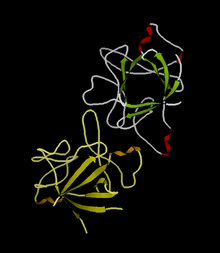Anakinra
 |
|
| Clinical data | |
|---|---|
| Trade names | Kineret |
| AHFS/Drugs.com | Monograph |
| MedlinePlus | a602001 |
| Pregnancy category |
|
| Routes of administration |
Subcutaneous |
| ATC code | |
| Legal status | |
| Legal status | |
| Pharmacokinetic data | |
| Bioavailability | 95% |
| Metabolism | predominantly renal |
| Biological half-life | 4-6 hrs |
| Identifiers | |
|
|
| CAS Number | |
| DrugBank | |
| ChemSpider |
|
| UNII | |
| KEGG | |
| ChEMBL | |
| Chemical and physical data | |
| Formula | C759H1186N208O232S10 |
| Molar mass | 17,257.6 g/mol |
|
|
|
Anakinra (brand name Kineret) is a drug used to treat rheumatoid arthritis. It is an interleukin 1 (IL1) receptor antagonist. It is produced by Swedish Orphan Biovitrum.
Anakinra is a recombinant version of the interleukin 1 receptor antagonist (IL1-RA). Anakinra differs from native human IL-1Ra in that it has the addition of a single methionine residue at its amino terminus Anakinra blocks the biologic activity of naturally occurring IL-1, including inflammation and cartilage degradation associated with rheumatoid arthritis, by competitively inhibiting the binding of IL-1 to the Interleukin-1 type receptor, which is expressed in many tissues and organs. IL-1 is produced in response to inflammatory stimuli and mediates various physiologic responses, including inflammatory and immunologic reactions. IL-1 additionally stimulates bone resorption and induces tissue damage like cartilage degradation as a result of loss of proteoglycans. In patients with rheumatoid arthritis the natural IL-1 receptor antagonist is not found in effective concentrations in synovium and synovial fluid to counteract the elevated IL-1 concentrations in these patients.
Anakinra is not considered a 'disease-modifying antirheumatic drug' (DMARD) but rather a 'biological response modifier' (BRM) because its able to selectively target the pathologic element of the disease.
The anakinra molecule is a recombinant, non-glycosylated version of human IL-1RA (RA for receptor antagonist) prepared from cultures of genetically modified Escherichia coli using recombinant DNA technology. It consists of 153 amino acids and has a molecular weight of 17,257.6 g/mol (approx. 17.3 kilodaltons) and differs from native human IL-1RA in that it has the addition of a single methionine residue on its amino terminus.
...
Wikipedia
